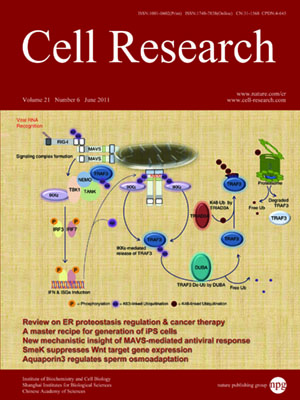
Volume 21, No 6, Jun 2011
ISSN: 1001-0602
EISSN: 1748-7838 2018
impact factor 17.848*
(Clarivate Analytics, 2019)
Volume 21 Issue 6, June 2011: 970-978
ORIGINAL ARTICLES
Phosphorylation switch modulates the interdigitated pattern of PIN1 localization and cell expansion in Arabidopsis leaf epidermis
>Hongjiang Li1,2, Deshu Lin2,3, Pankaj Dhonukshe4, Shingo Nagawa2, Dandan Chen2, Jiri Friml5,6, Ben Scheres4, Hongwei Guo1 and Zhenbiao Yang2
1National Laboratory of Protein Engineering and Plant Genetic Engineering, College of Life Sciences, Peking University, Beijing 100871, China
2Center for Plant Cell Biology, Department of Botany and Plant Sciences, University of California, Riverside, CA 92507, USA
3State Key Laboratory of Plant Physiology and Biochemistry, Department of Plant Sciences, College of Biological Sciences, China Agricultural University, Beijing 100193, China
4Section of Molecular Genetics, Department of Biology, Utrecht University, Padualaan 8, 3584 CH, Utrecht, The Netherlands
5Department of Plant Systems Biology, Vlaams Instituut voor Biotechnologie, Ghent University, 9052 Gent, Belgium
6Department of Plant Biotechnology and Genetics, Ghent University, 9052 Gent, Belgium
Correspondence: Zhenbiao Yang,(yang@ucr.edu)
Within a multicellular tissue cells may coordinately form a singular or multiple polar axes, but it is unclear whether a common mechanism governs different types of polar axis formation. The phosphorylation status of PIN proteins, which is directly affected by the PINOID (PID) protein kinase and the PP2A protein phosphatase, is known to regulate the apical-basal polarity of PIN localization in bipolar cells of roots and shoot apices. Here, we provide evidence that the phosphorylation status-mediated PIN polarity switch is widely used to modulate cellular processes in
Arabidopsis including multipolar pavement cells (PC) with interdigitated lobes and indentations. The degree of PC interdigitation was greatly reduced either when the
FYPP1 gene, which encodes a PP2A called phytochrome-associated serine/threonine protein phosphatase, was knocked out or when the
PID gene was overexpressed (
35S::PID). These genetic modifications caused PIN1 localization to switch from lobe to indentation regions. The PP2A and PID mediated switching of PIN1 localization is strikingly similar to their regulation of the apical-basal polarity switch of PIN proteins in other cells. Our findings suggest a common mechanism for the regulation of PIN1 polarity formation, a fundamental cellular process that is crucial for pattern formation both at the tissue/organ and cellular levels.
Cell Research (2011) 21:970-978. doi:10.1038/cr.2011.49; publishe online 22 March 2011
FULL TEXT | PDF
Browse 1978


